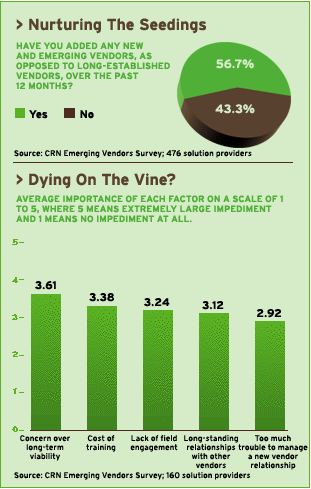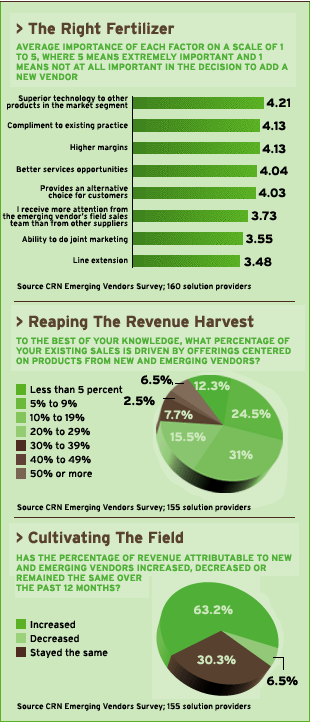Channel-Friendly Upstarts Dangle Better Profits
| /**/ /**/ |
They may not be household names, but their importance to solution providers is immeasurable. They are the wave of emerging technology vendors fast flooding the market and hungry to use solution providers as their primary sales route.
\
\
The cast of upstart companies covers a gamut of technologies, including storage, security and open-source products. Many are startups, often only a few years old, but they're well-financed and run by technology veterans who have carved out unique but strategic niches in the IT tapestry. As larger vendors keep tighter reins on budgets, these new vendors collectively represent the IT industry's cutting-edge R&D.
\
\
Not since the dot-com phenomenon at the turn of the century has there been such an infusion of new companies with new technologies bent on disrupting the way that old-guard IT vendors and their channel partners conduct business. But unlike the dot-com mirage, these new emerging vendors are real companies with real technologies, and solution providers that join forces with them are making real money.
\
\
"When I have [a Hewlett-Packard] deal where I make two to three points of margin and then I add CommVault [Systems'
tools, that] makes 40 points of margin," said John DeRocker, senior vice president of sales and marketing at Nexus Information Systems, a Plymouth, Minn., solution provider. "That's why it's imperative that you add these emerging technologies on top of a deal."
\
\
More than half the companies included in CRN's new
of 75 emerging vendors so far have bypassed distributors and are working directly with solution providers to carve out their niches in the market. In a world that is rapidly migrating from point products to solution sales, solution providers report that these emerging vendors with their cutting-edge technologies have become their secret profit elixirs. Indeed, so valuable and so strategic are their relationships with lesser-known vendors that some solution providers closely guard their partner rosters. DeRocker said he will incorporate a new data
vendor into his business next year. When asked the vendor's name, DeRocker said, "I'd rather keep them quiet."
\
\
Another solution provider, who requested anonymity, said: "I don't want to reveal who my emerging vendor partners are because they are giving us a competitive
in the marketplace, and we don't want our competitors to know who we are partnering with."
Margins And Momentum
While many solution providers are salting their storage, security and managed services solutions with a slew of new vendors offering product margins that are routinely three times those they see with brand-name vendors, most continue their relationships with their longtime tier-one vendor partners, such as Cisco Systems, EMC, HP, IBM and Microsoft.
But some solution providers, weary of the over-distribution and low margins that are characteristic of relationships with most tier-one manufacturers, have abandoned their traditional partners and are casting their lots with emerging vendors.

The more lucrative payoff on both the reseller and customer side of the equation is what drove Chad Agate and his partner, Robert Weiss, to sell off their stake last year in Cipher Group, a Tinley Park, Ill.-based solution provider focused on Cisco and Microsoft, and open up a new business, SIPBox, to focus on the open-source
market as a Digium premier partner. The bottom line: 10 percent product margins for a Cisco-based solution vs. 50 percent product margins on the Digium Asterisk open-source telecom product line, said Agate, CEO of SIPBox. And that doesn't include services revenue that can be twice as high on the Digium solutions side. More important, customers are happier because they are paying less than half the cost of a comparable Cisco solution for a more customized, feature-rich Asterisk solution, Agate said.
\
\
"This is absolutely phenomenal," he said of the momentum behind Digium and the Asterisk open-source
product set. "It's a lot of fun and really exciting. We're giving people a solution that doesn't cost an arm and a leg and is easily supportable. This makes technology extremely exciting again.
\
\
"Open-source software throws off the entire market," Agate added. "Our personal philosophy is we really enjoy working with disruptive technologies. Digium and Asterisk really shake up the playing field.
\
\
One example: a SIPBox win in the summer against Cisco and Mitel resellers on a contract for the ECHO Joint Agreement Project, a Chicago-area school district organization contract. On that deal, SIPBox's bid of $79,010 was less than half the $177,503 bid put forth by the Mitel reseller, nearly $55,000 below the $133,934 bid brought to the
by the Cisco reseller and $82,413 less than an AT&T direct bid of $161,423 using Cisco equipment, Agate said. He said Cisco deals tend to be licensing- and maintenance-heavy, whereas working with Digium provides him with twice as much services revenue and allows him to deliver more value to his customers.
\
\
"The numbers just don't make sense for a reseller to implement a Cisco solution," he said. "If you have the engineering staff, it makes absolute sense for any reseller to look at the Digium solution."
| /**/ /**/ |
'Talk About Channel-Friendly'
\
Solution providers say the reason they are seeing eye-popping margins from emerging vendors is the marriage of cutting-edge technology with a voracious appetite to use solution providers as their primary route to market. Even though the vendors may be relatively small and unknown, solution providers say the emerging vendors seem to understand solution providers better than the larger, tier-one vendors.
\
\
"They need us more than we need them compared to larger vendors," said Scott Pelletier, vice president of enterprise sales and engineering at Lewan & Associates, a Denver-based solution provider. "Talk about channel-friendlyit's over the top [with emerging vendors]. Larger vendors look to expand their business by having a channel, but don't look at the channel as their primary means of distribution, especially in the larger accounts. If you have a vendor partner where 99 percent of the business goes through the channel, you know you're not going to get hosed by them taking things direct."
\
\
Pelletier, who counts LeftHand Networks, a clustered open
vendor, as one of his best emerging vendor partners, said the new breed of channel-friendly vendors purposely builds more gross margins into their products and protects partners with limited distribution and account registration programs. "With EMC or HP, we do good to get 15 points of margin, but with LeftHand, we're guaranteed 20 to 25 points every time," he said. "Also, when we compete against someone like NetApp, the price [from LeftHand] is three-fourths of what NetApp costs. We look better from a price perspective, but the margin is still there."
\
\
Rob Wolfe, president and CEO of AvcomEast, a solution provider in Vienna, Va., agreed that there is a marked difference in partnering with an emerging vendor rather than an established market-leading manufacturer. "When we first engage with a big vendor, they take a show-me attitude with a new solution provider," he said. "With an emerging vendor, it feels more like investment in our mutual success."
\
\
Samir Doshi, president of Telecomers, a solution provider in Irvine, Calif., agreed that working with smaller vendors is much easier because their channel programs are less complex than those of larger, established manufacturers. Doshi said his primary emerging vendor partner is Network Physics, an application performance management appliance company in Mountain View, Calif.
\
\
"We are a small company, and Network Physics' channel program makes it a lot easier to work with them," he said. "Larger companies have
and volume requirements. Large organizations like HP and IBM are not small business-friendly."
Maturity A Must
Solution providers say that while new vendors eager to work with the channel are flooding the market, they still go through a detailed screening process before adding emerging vendors to their roster of partners. While sound technology is the starting point, solution providers say emerging vendors need to display some maturity in both their channel programs and business processes. In describing the ideal emerging vendor, Wolfe said, "We want mature companies with sound technology and good business processes but [that] are missing a market maturity component to their business."
He said that astute emerging vendors realize solution providers add that missing market maturity piece to their business.
But Wolfe said figuring out which companies to partner with involves a learning curve. One of the first emerging vendors he signed up with looked as if it had an inexpensive high-performance NAS product. "We got in early, but we waited nine months for them to deliver a product, and we spent a lot of time twiddling our thumbs waiting. It was a vendor not ready for prime time."
Wolfe took the lesson learned from that initial debacle and now has a formal process in place when adding a vendor. "I have to resist my own temptation for what looks like a cool technology," he said. "Now, when we look at a vendor, it's decision by committee."
He said AvcomEast's director of

sales checks out the vendor's channel programs and market presence, including contacting several of the company's customers. And the technical services manager makes sure the company has a viable product. "We've got the hang of it now and get it right about 80 percent of the time," he said.
\
\
Tobi Evangelisti, vice president of solutions at GreenPages, a Kittery, Maine, solution provider, said her company also has a formal screening process for emerging vendors. She said that the director of solutions
in each of GreenPages' business practices first evaluates prospective new technologies in their respective areas. Then sales managers evaluate things such as deal registration programs and potential margins. Finally, GreenPages looks at the culture of the prospective vendor to determine if the company cultures are a good match.
\
\
"We look at the percent of direct vs. indirect business," she said. "If there is channel conflict, we look at how they handle it. We also want to know how their sales reps are paid, because that can dictate behavior [that might lead to potential conflicts]."
\
\
She said that GreenPages also examines the depth of engineering talent at a company as well as the list of current solution provider partners to make sure the product isn't over-distributed. But she notes the payoff for GreenPages' due diligence is enormous. "We can get margins between 15 and 45 points on emerging vendors, compared with 6, 10 or 12 points on an HP server. It's a big difference," Evangelisti said.
\
\
Lewan & Associates' Pelletier added, "We look at the stability of the company and then engage them slowly. We like to test the water just to make sure."
\
\
He noted that beyond product margins, emerging vendors open up a whole slew of service opportunities. He said that emerging vendors need solution providers to help with implementation services as well as product sales. "I get good margins on implementation services as well, which guarantees stickiness between solution providers and emerging vendors," he said. "With HP and EMC, I have to fight them to do those services. They want to get in the middle and recognize the revenue. But companies like LeftHand say, 'Just take the services.' They don't care."
\
\
Still, solution providers say that despite significantly higher margins from emerging vendors, the sales cycle is longer because there is little brand recognition for the small manufacturers. Wolfe, however, said this is ultimately good for the customer because it forces the solution provider to sell a solution rather than simply a product.
\
\
"How many people bought Dell with
because they thought it was right for their business when, in fact, maybe they should have bought blades or Sun or Red Hat?" he said.